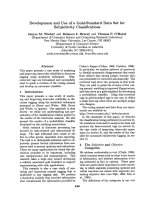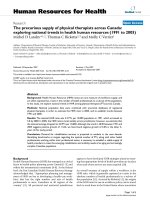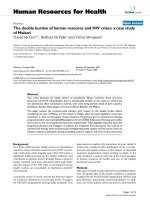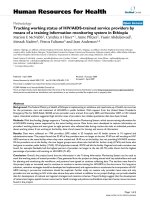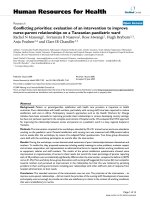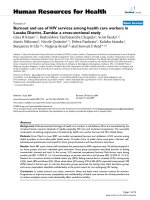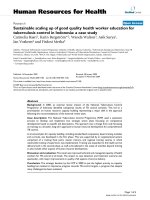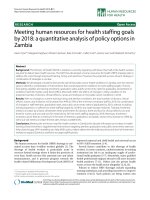báo cáo sinh học:" Tracking working status of HIV/AIDS-trained service providers by means of a training information monitoring system in Ethiopia" pdf
Bạn đang xem bản rút gọn của tài liệu. Xem và tải ngay bản đầy đủ của tài liệu tại đây (178.45 KB, 8 trang )
BioMed Central
Page 1 of 8
(page number not for citation purposes)
Human Resources for Health
Open Access
Methodology
Tracking working status of HIV/AIDS-trained service providers by
means of a training information monitoring system in Ethiopia
Marion E McNabb
1
, Cynthia A Hiner*
1
, Anne Pfitzer
2
, Yassir Abduljewad
2
,
Mesrak Nadew
2
, Petros Faltamo
3
and Jean Anderson
1,4
Address:
1
Jhpiego, an affiliate of Johns Hopkins University, Baltimore, MD, USA,
2
Jhpiego, an affiliate of Johns Hopkins University, Ethiopia
country office, Addis Ababa, Ethiopia,
3
United States Centers for Disease Control and Prevention, Ethiopia country office, Addis Ababa, Ethiopia
and
4
Johns Hopkins University School of Medicine, Department of Obstetrics and Gynecology, Baltimore, MD, USA
Email: Marion E McNabb - ; Cynthia A Hiner* - ; Anne Pfitzer - ;
Yassir Abduljewad - ; Mesrak Nadew - ; Petros Faltamo - ;
Jean Anderson -
* Corresponding author
Abstract
Background: The Federal Ministry of Health of Ethiopia is implementing an ambitious and rapid scale-up of health care services
for the prevention, care and treatment of HIV/AIDS in public facilities. With support from the United States President's
Emergency Plan for AIDS Relief, 38 830 service providers were trained, from early 2005 until December 2007, in HIV-related
topics. Anecdotal evidence suggested high attrition rates of providers, but reliable quantitative data have been limited.
Methods: With that funding, Jhpiego supports a Training Information Monitoring System, which stores training information for
all HIV/AIDS training events supported by the same funding source. Data forms were developed to capture information on
providers' working status and were given to eight partners who collected data during routine site visits on individual providers
about working status; if not working at the facility, date of and reason for leaving; and source of information.
Results: Data were collected on 1744 providers (59% males) in 53 hospitals and 45 health centres in 10 regional and
administrative states. The project found that 32.6% of the providers were no longer at the site, 57.6% are still working on HIV/
AIDS services at the same facility where they were trained and 10.4% are at the facility, but not providing HIV/AIDS services.
Of the providers not at the facility, the two largest groups were those who had left for further study (27.6%) and those who
had gone to another public facility (17.6%). Of all physicians trained, 49.2% had left the facility. Regional and cadre variation was
found, for example Gambella had the highest percent of providers no longer at the site (53.7%) while Harari had the highest
percentage of providers still working on HIV/AIDS (71.6%).
Conclusion: Overall, the project found that the information in the Training Information Monitoring System can be used to
track the working status of trained providers. Data generated from the project are being shared with key stakeholders and used
for planning and monitoring the workforce, and partners have agreed to continue collecting data. The attrition rates found in
this project imply an increased need to continue to conduct in-service training for HIV/AIDS in the short term. For long-term
solutions, retention strategies should be developed and implemented, and opportunities to accelerate the incorporation of HIV/
AIDS training in pre-service institutions should be explored. Further study on reasons why providers leave sites and why
providers are not working on HIV at the sites where they were trained, in addition to our project findings, can provide valuable
data for development of national and regional strategies and retention schemes. Project findings suggest that the development
of national and region-specific human resources for health strategy and policies could address important human resources issues
found in the project.
Published: 1 April 2009
Human Resources for Health 2009, 7:29 doi:10.1186/1478-4491-7-29
Received: 17 January 2008
Accepted: 1 April 2009
This article is available from: />© 2009 McNabb et al; licensee BioMed Central Ltd.
This is an Open Access article distributed under the terms of the Creative Commons Attribution License ( />),
which permits unrestricted use, distribution, and reproduction in any medium, provided the original work is properly cited.
Human Resources for Health 2009, 7:29 />Page 2 of 8
(page number not for citation purposes)
Background
Ethiopia has a population of approximately 77 million
people, with nearly 83% living in rural areas [1]. Ethiopia
does not have a sufficient health care workforce to meet
the population's demand for services and the burden of
disease. The country is far below the World Health Organ-
ization (WHO) recommended standard of one physician
for every 10 000 persons, with a total of 2115 physicians
– translating to only one physician for 36 407 persons. In
terms of nurses, Ethiopia is above the WHO-recom-
mended one nurse per 5000 people, with one nurse per
4314 individuals [2]. However, a substantial proportion
of nurses are junior nurses with only certificate-level (two
years) qualification.
The existing human resources (HR) for health crisis can
significantly impede Ethiopia's attempts to attain ambi-
tious targets to scale up primary health care services, as
well as to reach goals for universal access to HIV/AIDS pre-
vention, care and treatment services by 2010. A 2003
study noted that, given current HR, there would be a
14%–66% gap in physicians necessary to address both
basic health services and direct HIV/AIDS care needed to
reach HIV/AIDS prevention, care and treatment goals of
the Ethiopian government, the United States President's
Emergency Plan for AIDS Relief (PEPFAR) and the Global
Fund to Fight AIDS, Tuberculosis and Malaria [3].
Human capacity building – including training service pro-
viders in all areas of HIV prevention, care and treatment –
is a significant component of PEPFAR Ethiopia support to
the Federal Ministry of Health (FMOH) HIV/AIDS pro-
gramme. From April 2007 to March 2008, PEPFAR
planned to support training of 124 920 persons in all
areas of HIV/AIDS prevention, treatment, care and sup-
port (United States Government Country Operational
Plan for Ethiopia for PEPFAR 2007). While not all of these
individuals are health care workers – many are commu-
nity-based workers and other cadres of workers – this still
represents a massive training and human capacity build-
ing effort for HIV/AIDS. Over the past two years, training
budgets accounted for 30%–40% of the total PEPFAR
funding for Ethiopia.
With funding from PEPFAR, through the United States
Centers for Disease Control and Prevention (CDC),
Jhpiego supports a Training Information Monitoring Sys-
tem (TIMS
©
), which stores key participant and training
information for all PEPFAR-funded training events. This
paper describes a project that uses training data from the
TIMS database to follow up providers after training to
assess whether they are still working in HIV/AIDS-related
services. The objective of this project was to assess the use-
fulness and feasibility of collecting these data for monitor-
ing and planning of HIV/AIDS services.
Methods
Implementation of the project
TIMS is a Microsoft Access database designed by Jhpiego
in 1997 to track Jhpiego's competence-based training
courses, capturing key information on participants, train-
ers and courses. TIMS in Ethiopia tracks course informa-
tion by PEPFAR-implementing partners and links courses
to an overall focus area that matches PEPFAR focus areas.
The United States Agency for International Development
(USAID) and CDC Ethiopia require that PEPFAR-imple-
menting partners report training data for entry into TIMS.
As of the beginning of the project in January 2007, 26
partners had reported training information – totaling 31
284 trained providers and 1038 courses.
With input from key stakeholders, Jhpiego developed a
tool to collect information about trained providers on:
HIV/AIDS working status (yes/no); percentage level of
effort for HIV/AIDS services; if not working on HIV/AIDS,
reasons why not and date of departure from the facility
(when applicable); and the method of collecting data
(orally, from official HR records, etc.). Each tool was com-
pleted for the individual hospital or health centre with
information on the service provider trained, date of train-
ing, course name, profession and gender. Jhpiego staff
pretested this data collection tool prior to the project and
made minor changes before the project's rollout.
Eight PEPFAR partners, including Jhpiego, were selected
to participate in the project based on their role in the
direct implementation of clinical HIV/AIDS services for
hospitals and health centres. Since the selected partners
regularly visit sites where HIV/AIDS services are delivered,
the planned supervision visits were used to collect data for
the project. Data collection occurred between February
and June 2007. The original data set chosen for the project
included 6353 providers who were either trained by the
partners participating in the project or were working at the
facilities where those partners were supporting HIV service
implementation. Public and military hospitals were
included in the data set because PEPFAR supports HIV/
AIDS services at these facilities. In addition, some of the
partners participating in the project had been asked by the
MOH's HIV/AIDS Prevention and Control Office and
other government stakeholders to support HIV services at
private hospitals; thus, the analysis also included trained
HIV/AIDS service providers from private hospitals.
Jhpiego provided the partners with forms containing the
name, profession and courses attended for each of the par-
ticipants so that follow-up data could be collected on an
individual basis at each facility. In some cases, training
information was not yet entered into TIMS, and the part-
ners collected all training information about the providers
and their HIV/AIDS working status during their routine
Human Resources for Health 2009, 7:29 />Page 3 of 8
(page number not for citation purposes)
site visits. The method of data collection (e.g. administra-
tor's official record, orally from administrator, etc.) was
also recorded to help understand the quality of HR
records kept by the hospital and to monitor the quality of
data collected. The completed forms were sent to Jhpiego,
where Jhpiego staff compiled and entered the data and
conducted the analysis by means of SPSS and SAS soft-
ware.
Some partners reported being unable to find information
on some providers, and these providers were removed
from the analysis. In addition, if partners did not have
scheduled visits to some of the facilities they supported,
data were not collected from those sites and those provid-
ers were excluded from the analysis.
The partners were asked to complete an evaluation form
to gather feedback on the usefulness of the data, the ease
or difficulty of collecting the data, and the perceived use
of these data during regular programme monitoring. This
information will be used to help determine whether this
type of data collection will occur on a routine basis as part
of the TIMS programme.
Data analysis
The responses for several variables – training focus, quali-
fication and reason for not being at the site – were
grouped into "other" if the sample size was small and rep-
resented less than 2% of the total sample. Approximately
26% of the responses for reasons why they were not work-
ing at the site were "don't know," and these responses
were left in the analysis because they represent data where
it was known people had left, but the reason was
unknown. For people who were working in HIV, data
were collected on their percentage of time working in HIV
(1%–100%); however, for this analysis everyone was
grouped as working in HIV regardless of their levels of
effort.
Attrition in this analysis is defined as the provider's no
longer working at the site at the time of the supervision
visit. Responses for reason for leaving included: left for
further study, joined a nongovernmental organization
(NGO), joined the private sector, transferred to another
public facility, other (which included changed profes-
sions, left the country, deceased) and unknown. Breaking
down attrition as defined above, there are two groups of
health care workers: those leaving the public health sector
entirely or for reasons unknown, and those transferring to
another public facility. Of those who transferred to
another public facility, we are unsure if they are still pro-
viding HIV/AIDS services, and there are no formal systems
for providers who transfer to a new facility to report prior
training courses they have attended. They are considered
part of the attrition category. Ultimately, in the overall
analysis, we focus on the providers who have left the site
(32% of the total trained), since the loss of those provid-
ers requires managers to train new providers as replace-
ments.
The data were analysed by means of SAS software. Sum-
mary statistics were generated with gender, type of pro-
vider, type of facility, working status and reasons for
leaving as the categorical variable. Chi-square was per-
formed to analyse comparisons by variables potentially
related to attrition. For the chi-square analysis, attrition
was further grouped by HIV-working status into "working
in HIV" and "not working in HIV." The latter category
included individuals who were at the site but were not
providing HIV services, grouped with those who were no
longer at the site. The chi-square was also performed using
a grouping of those "at the site" and "not at the site", but
the results of the analysis were similar. The HIV-working
status was used because it more accurately reflects the con-
cept being discussed. Working status was analysed based
on work location by grouping regions into established
regions (Addis Ababa; Amhara; Dire Dawa; Harari; Oro-
mia; Southern Nations, Nationalities and Peoples States
(SNNPR)); Tigray; and emerging regions (Afar, Benishen-
gul Gumuz, Gambella and Somali). We also reviewed
working status by qualification and by number of courses
taken.
Results
Of the 6353 service providers with information provided,
a total of 1744 service providers were followed up from 53
hospitals and 45 health centres in 10 of 11 regional and
administrative states. Nearly 88% of the providers worked
in a hospital and 59% were male. Fifty-seven percent were
nurses and/or midwives, while 14% were physicians; all
other professions each represented less than 10% of the
sample. Of the 1744 providers, 1344 had taken only one
HIV course, while the remaining 400 had taken at least
two courses (Table 1). Of the recorded data collection
methods, most data were collected orally through conver-
sations with either a health worker (56%), a site adminis-
trator (14%) or the trained individual themselves (16%).
Of the providers, 57.6% were found at the site and work-
ing with some level of effort on HIV/AIDS services; 10.4%
of the providers were working at the site, but reported not
to be working on HIV/AIDS services; and 32% were no
longer working at the site (Table 2). Of the 32% who had
left the site, reasons for leaving included joining the pri-
vate sector (10.2%), joining an NGO (9.7%), leaving for
further study (27.6%), working in another public facility
(17.6%), other (8.6%) and unknown (26.3%) (Table 3).
Of all the providers no longer at the facility at the time of
the visit, 82.4% were no longer working in the public sec-
tor and can be considered "lost," while 17.3% transferred
to another public facility and were still part of the public
Human Resources for Health 2009, 7:29 />Page 4 of 8
(page number not for citation purposes)
sector health care workforce. Data were not collected on
the 17.3% of the providers, so it is not known if they were
working in HIV/AIDS services. For the different chi-square
analyses, working status was grouped into "working in
HIV" (57.3%) and "not working in HIV" (42.7%). This
was analysed by established regions versus emerging
regions. We found that providers who had been working
at facilities in emerging regions when they were trained
were less likely still to be working at those sites than those
working in established regions (p < .0001).
In addition to an analysis by region, we explored attrition
and the reported destination by profession. Pharmacists
and lab personnel were the most likely to have joined the
private sector (18% and 19%, respectively); while 32%
and 28%, respectively, had transferred to other public
facilities. Sixteen percent of physicians joined the private
sector, and were also the most likely (19%) to have joined
an NGO. Nurses and/or midwives were the most likely to
have left for further study (35%). (This is likely correlated
with the implementation of the Accelerated Training for
Health Officers, a key national strategy to expand the
number of this new cadre to provide curative services at
health centres and to manage woreda (district) health
offices. Diploma-level health care workers are eligible for
the accelerated programme.) However, when overall
working status by nurses and/or midwives was compared
to all other professions, the difference was statistically sig-
nificant for physicians and specialists (p < .0001) and
administrators and management (p = .0091), with both
groups less likely still to be working in HIV than those in
the nurse and/or midwife group (Table 4). Finally, we
found that providers were just as likely to be working if
they had attended one training course or more than one
training course.
Sixty percent of the partners found that collecting these
data during site visits was not burdensome. All partners
agreed to collect this information in the future and recom-
mended that these data be collected on a semiannual
basis. Eighty percent of partners reported that they would
use the information for planning and monitoring pur-
poses.
Discussion
Given the significant resources devoted to training health
care workers in Ethiopia, tracking whether providers
trained to deliver HIV/AIDS services are indeed providing
Table 1: Characteristics of health care workers followed-up, by region
Region (n) Worked at a hospital Male Physicians or
specialists
Nurses and/or
midwives
Took two or more
classes
Addis Ababa
(334)
285 85.6% 162 48.5% 73 21.9% 181 54.2% 81 24.3%
Afar (30) 22 76.7% 20 66.7% 6 20.0% 16 53.3% 10 33.3%
Amhara
(138)
138 100% 81 58.7% 25 18.1% 79 57.3% 30 21.7%
Benishangul-
Gumuz (84)
84 100% 66 78.6% 12 14.3% 48 57.1% 25 29.8%
Dire Dawa
(63)
49 77.8% 35 55.6% 9 14.3% 42 66.7% 8 12.7%
Gambella
(41)
41 100% 34 82.9% 4 9.8% 27 65.9% 16 39.0%
Harari (194) 194 100% 108 55.7% 18 9.3% 141 72.7% 12 6.2%
Oromia
(227)
84 37.0% 127 56.0% 8 3.5% 161 70.9% 19 8.4%
SNNPR (474) 473 99.8% 291 61.4% 60 12.7% 216 45.6% 144 30.4%
Tigray (159) 159 100% 107 67.3% 25 15.7% 87 54.7% 55 34.6%
Total
(1744)
1529 87.8% 1031 59.1% 240 13.8% 998 57.2% 400 22.9%
Human Resources for Health 2009, 7:29 />Page 5 of 8
(page number not for citation purposes)
Table 2: Working status of health care workers followed-up, by region
Region (n) No longer working at the site At the site but not working in HIV At the site and working in HIV
Addis Ababa (334) 103 30.8% 55 16.5% 176 52.7%
Afar (30) 15 50.0% 2 6.7% 13 43.3%
Amhara (138) 33 23.9% 11 8.0% 94 68.1%
Benishangul-Gumuz (84) 39 46.4% 13 15.5% 32 38.1%
Dire Dawa (63) 12 19.0% 0 0.0% 51 81.0%
Gambella (41) 22 53.7% 5 12.2% 14 34.1%
Harari (194) 43 22.2% 12 6.2% 139 71.6%
Oromia (227) 62 27.3% 20 8.8% 145 63.9%
SNNPR (474) 185 39.0% 33 7.0% 256 54.0%
Tigray (159) 44 27.7% 30 18.9% 85 53.5%
Total (1744) 558 32.0% 181 10.4% 1005 57.6%
Table 3: Reasons why health care workers are no longer at their sites, by region
Region Further Study Joined Private Sector Joined NGO Another Public Facility Other Unknown
Addis Ababa (103) 20 19.4% 9 8.7% 13 12.6% 12 11.7% 16 15.5% 33 32.0%
Afar (15) 7 46.7% 2 13.3% 5 33.3% 0 0.0% 0 0.0% 1 6.7%
Amhara (33) 10 30.3% 1 3.0% 2 6.1% 6 18.2% 1 3.0% 13 39.4%
Benishangul-Gumuz (39) 10 25.6% 4 10.3% 5 12.8% 10 25.6% 3 7.7% 7 17.9%
Dire Dawa (12) 6 50.0% 2 16.7% 0 0.0% 1 8.3% 1 8.3% 2 16.7%
Gambella (22) 13 59.1% 1 4.5% 3 13.6% 1 4.5% 0 0.0% 4 18.2%
Harari (43) 7 16.3% 2 4.7% 3 7.0% 5 11.6% 9 20.9% 17 39.5%
Oromia (62) 24 38.7% 3 4.8% 6 9.7% 17 27.4% 2 3.2% 10 16.1%
SNNPR (185) 49 26.5% 23 12.4% 10 5.4% 36 19.5% 10 5.4% 57 30.8%
Tigray (44) 8 18.2% 10 22.7% 7 15.9% 10 22.7% 6 13.6% 3 6.8%
Total (558) 154 27.6% 57 10.2% 54 9.7% 98 17.6% 48 8.6% 147 26.3%
Human Resources for Health 2009, 7:29 />Page 6 of 8
(page number not for citation purposes)
those services in public facilities is important for monitor-
ing and evaluation of programme implementation and
for programme planning. TIMS in Ethiopia provides an
opportunity to capture this information in a meaningful
and collaborative context.
This project noted a very high attrition rate, with 32% of
providers having left their original work sites – overall,
24.6% were no longer in the public sector. This rate is
alarmingly high, and further exploration into "push and
pull" factors is warranted. Physicians had the highest
attrition, with more than 49% no longer at the sites and
fewer than 6% having transferred to another public facil-
ity. This rate is almost twice as high as that found in a
2006 study from Ethiopia's FMOH, which reported an
attrition rate from the public sector of 26% for physi-
cians [4]. Another report calculated an attrition rate of
9.6% among physicians in Ethiopia by comparing the
number of physicians graduating in a year and the
number working in a year [3].
Ten percent of health providers who had left the facility
were reported to have joined the private sector, and an
additional 10% were reported to have joined an NGO.
The 10.6% of providers who remained at the site but were
not working in HIV requires further attention and empha-
sizes the potential need to better target training resources
and improve selection of health care workers to be
trained. In one region, Tigray, where 18.9% of workers
were reassigned within a facility, staff from the Regional
Health Bureau reported that they considered training as a
tool to improve retention (Tadesse Y: Report on a Reten-
tion Fact Finding Visit to Mekelle. December 2007). This
finding suggests that other factors beyond HIV/AIDS-
related service delivery needs may influence the selection
of providers for training.
We also found considerable regional variation in attrition
rates. Recognition of these trends and regional differences can
influence decision-making at the regional and national levels
to ensure that HIV/AIDS services are adequately staffed.
Through this project, we found that using information
gathered in a standardized way by PEPFAR partners dur-
ing routine supervision visits and entered into the TIMS
database demonstrates an innovative and effective way to
monitor the HIV/AIDS workforce. Such monitoring con-
tributed to the partners' ability to ensure coverage of
trained providers to deliver services and helped inform
planning for replacement training, where applicable, at
little additional cost. Partners requested region- and site-
specific analyses for use in planning for replacement train-
ing and have also used these data to negotiate with
regional health bureaux for effective retention strategies.
The collection of all training data in one central database
allowed access to a comprehensive list of providers
trained at individual sites, regardless of which organiza-
tion supported the training, and facilitated comprehen-
sive site-level HIV/AIDS workforce assessments.
In the absence of a national human resource information
system (HRIS), the findings of this project provided the
potential to look at the working status of a large country-
wide cohort of providers and helped facilitate and inform
planning by regional health bureaux and the FMOH,
which will ensure that adequate numbers of staff are avail-
able to deliver comprehensive HIV/AIDS services and
develop evidence-based retention strategies.
Table 4: Work status of health care workers, by profession
Profession No longer working at the site At site but not working in HIV At site and working in HIV
Administrator/management (62) 28 45.2% 7 11.3% 27 43.5%
Physician/specialist (240) 118 49.2% 18 7.5% 104 43.3%
Health officer (79) 19 24.1% 7 8.9% 53 67.1%
Nurse, midwife, nurse/midwife (998) 271 27.2% 125 12.5% 602 60.3%
Pharmacist/druggist (100) 38 38.0% 9 9.0% 53 53.0%
Laboratory (136) 43 31.6% 5 3.7% 88 64.7%
Sanitarian/environmental health (46) 19 41.3% 1 2.2% 26 56.5%
Other or unknown (83) 22 26.5% 9 10.8% 52 62.7%
Total (1744) 558 32.0% 181 10.4% 1005 57.6%
Human Resources for Health 2009, 7:29 />Page 7 of 8
(page number not for citation purposes)
Furthermore, routine analysis of TIMS follow-up data may
inform and provide a means to monitor the effectiveness
of retention strategies. The TIMS database can also facili-
tate mapping of the workforce to support the use of these
data for general as well as HIV/AIDS-specific workforce
planning.
The attrition found through this project suggests that a
stop-gap approach to train more service providers may be
necessary to meet HIV/AIDS service demand. However,
this is not a sustainable solution and requires significant
resources to maintain a standard level of trained provid-
ers. Other options include task shifting of certain care
responsibilities to lower-level cadres of health care work-
ers or creation of a specialized cadre of HIV/AIDS workers.
Various retention schemes should be developed, imple-
mented and evaluated at both a national and regional
level. Current human resource practices in the health sec-
tor should be reviewed and national guidelines/policies
regarding human resources for health should be devel-
oped to address problem areas identified through this
project.
As the need for HIV/AIDS services continues to increase in
Ethiopia, more trained professionals will be needed, high-
lighting the need to focus efforts towards greater integra-
tion of HIV/AIDS content into pre-service education to
ensure that new graduates have the base knowledge, skills
and attitudes to provide various HIV/AIDS-related serv-
ices.
Limitations
Despite the large TIMS data set of trained providers, there
is a significant lag time for reporting and data entry into
TIMS, with only 38 380 persons in the database as of
December 2007, compared to the projected 124 920 peo-
ple who are to be trained by March 2008. However, the lag
time is comparable across partners and regions and, there-
fore, the sample analysed in this study is believed to be
representative.
It is important to note that the numbers generated con-
cerning attrition in this project are specific to providers
trained in HIV/AIDS services in Ethiopia, and may not be
generalized to other service areas or the Ethiopian work-
force in general. There may be some characteristics of
these individuals that make them different from other
health care workers who have not had HIV/AIDS training
opportunities.
The majority of data was collected orally from health care
workers rather than from administrative records. Data
were collected from official HR records at only a few sites,
highlighting the need to support site-level HR manage-
ment at public facilities. Information was not available for
the individuals who had left sites where they had received
training, but had transferred to another public sector site.
It is possible they are still working in HIV and, therefore,
do not represent true attrition from the HIV/AIDS public
health care sector. However, their transfer still has signifi-
cant site-level implications for maintaining services and
high-quality care.
Finally, data were not collected on the reasons why pro-
viders left the facility, in addition to where they went, or
were still at the facility but not working on HIV/AIDS, lim-
iting the scope of information usable to develop targeted
retention schemes.
Conclusion
The project successfully demonstrated that data found in
TIMS can be used for following providers trained in HIV/
AIDS to assess their HIV/AIDS working status and evalu-
ate attrition. With longer follow-up, there is an opportu-
nity to collect information on time and geographical
trends. Key government stakeholders are actively using
this information for HIV/AIDS workforce planning.
Based on the project findings, we recommend that track-
ing of trained HIV/AIDS health care workers through the
use of TIMS be rolled out to all health care facilities. The
data should be routinely analysed and disseminated to
key stakeholders, to inform planning for HIV/AIDS train-
ing needs and development of retention schemes. Data on
the reasons why providers leave the facility and why
trained providers are not working on HIV at the facility
post training should be collected to have a broader under-
standing of the "push and pull" factors in order to develop
targeted retention schemes.
The study findings also highlight the need for national
and regional specific policies and guidelines regarding
human resources for health to be developed and imple-
mented at all levels to address problem areas found in the
study. This study points out the need to strengthen and
expand pre-service programmes aimed at incorporating
HIV/AIDS competences into the curriculum. This study
also highlights the need for the FMOH and individual
regions to consider a national HR information system to
track movements of all health workers in Ethiopia.
Competing interests
The authors declare that they have no competing interests.
Authors' contributions
MEM contributed to the conception, design, implementa-
tion and analysis of project findings and dissemination of
findings, as well as writing the manuscript. CAH contrib-
uted to the conception, design and statistical analysis of
project data as well as overall technical and monitoring-
Publish with BioMed Central and every
scientist can read your work free of charge
"BioMed Central will be the most significant development for
disseminating the results of biomedical research in our lifetime."
Sir Paul Nurse, Cancer Research UK
Your research papers will be:
available free of charge to the entire biomedical community
peer reviewed and published immediately upon acceptance
cited in PubMed and archived on PubMed Central
yours — you keep the copyright
Submit your manuscript here:
/>BioMedcentral
Human Resources for Health 2009, 7:29 />Page 8 of 8
(page number not for citation purposes)
and-evaluation-related support for the project and writing
the manuscript. AP contributed to the conception, design
and implementation of the project as well as overall guid-
ance and oversight of project implementation and dis-
semination of findings. AP also contributed to the
manuscript. YA contributed to the conception, design,
implementation and overall guidance and support for the
project. YA also contributed to and reviewed the manu-
script. MN contributed to the implementation and analy-
sis of the findings and reviewed the manuscript. PF
contributed to the conception, design, implementation
and overall support for the project. PF also reviewed the
manuscript. JA contributed to the design and overall sup-
port for project implementation. JA also critically
reviewed the manuscript and has given the final approval
for Jhpiego/JHU publication.
Acknowledgements
The authors sincerely thank PEPFAR for funding the project, and CDC and
USAID Ethiopia offices and staff for their support in the implementation of
this project. The authors are grateful to CDC Ethiopia for the funding that
made this project possible. The authors would also like to acknowledge the
contribution of the PEPFAR Ethiopia implementing partners: without their
participation, the PEPFAR Ethiopia TIMS database and this project would
not have been possible. Thanks also to the facilities and providers who par-
ticipated in this project, and all other key stakeholders who made this
project possible.
References
1. Central Statistical Agency. Ethiopia 2007 [http://
www.csa.gov.et/surveys/National%20statistics/
national%20statistics%202006/Population.pdf].
2. Ethiopian Ministry of Health: Health and Health Related Indicators. Ethi-
opian calendar (2005/2006 Gregorian calendar) 1998.
3. Kombe G, Galaty D, Gadhia R, Decker C: Human and Financial
Resource Requirements for Scaling Up HIV/AIDS Services in Ethiopia
Bethesda, MD: The Partners for Health Reformplus Project, Abt
Associates Inc; 2004.
4. Federal Democratic Republic of Ethiopia Ministry of Health, World
Health Organization Ethiopia Country Office: Status of Human
Resources for Health in Ethiopia Concept Paper 2006.
